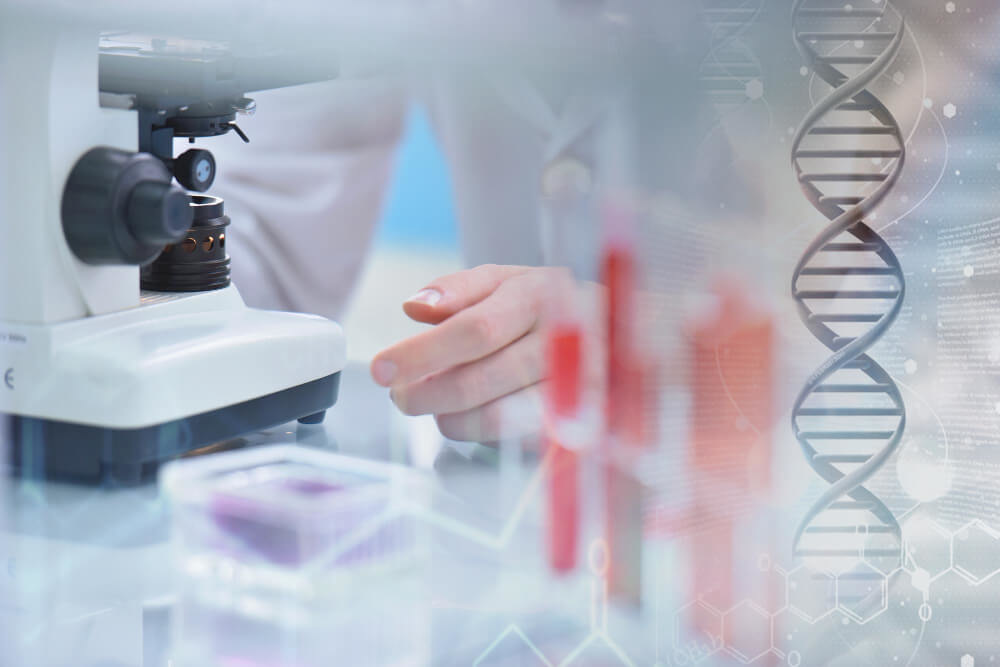Regenerative Medicine: Unlocking Your Body’s Innate Healing Code
Think about the last time you got a simple paper cut. Without any conscious effort, your body launched a complex and elegant healing cascade. Platelets rushed to the scene to form a clot, immune cells cleared away debris, and new skin cells grew to seal the wound. This remarkable, automatic process is a daily miracle we often take for granted.
Now, imagine taking that innate healing power and amplifying it. Imagine directing it with precision to areas of your body that are injured, degenerating, or succumbing to the effects of time. This is the groundbreaking premise of a medical field that is rapidly changing how we think about health, disease, and aging.
This approach represents a fundamental shift away from merely managing symptoms toward addressing the root cause of cellular damage. The core promise of regenerative medicine is to repair, replace, and restore function to damaged tissues and organs. It’s not about a magic pill; it’s about empowering the body’s own biological software to heal itself from within.

What Are the Core Principles of Regenerative Medicine?
At its heart, regenerative medicine operates on a simple yet profound principle: the human body possesses the tools for its own repair. Traditional medicine often focuses on external interventions, like pharmaceuticals to block a chemical pathway or surgery to remove a damaged part. Regenerative medicine, however, looks inward.
It seeks to provide the raw materials and biological signals necessary to kickstart the body’s restorative mechanisms. The goal is not just to patch a problem but to rebuild the tissue so it functions as it was meant to. This philosophy is often summarized by the ‘three Rs’: Repair, Replace, and Regenerate.
Repair involves stimulating damaged tissues to heal themselves. Replace means using healthy cells to take the place of diseased or damaged ones. Regenerate is the most ambitious goal, aiming to regrow entire tissues or even organs.
Crucially, many of these therapies utilize autologous materials, meaning they are sourced directly from the patient’s own body. This could be a sample of blood, fat tissue, or bone marrow. Using a patient’s own biological material significantly reduces the risk of rejection or adverse immune reactions, making it a highly personalized form of care.

What Are the Key Technologies and Therapies?
The field of regenerative medicine is not a single treatment but a collection of innovative technologies and therapeutic approaches. Each one leverages a different aspect of the body’s healing toolkit. Understanding these core components helps demystify how this new era of medicine actually works.

How Do Stem Cells Work in Healing?
Stem cells are perhaps the most well-known component of regenerative medicine. They are the body’s ‘master cells’ or ‘blank slates’. What makes them so special is their unique ability to develop into many different types of specialized cells, from a bone cell to a nerve cell to a skin cell.
While early research generated ethical debates surrounding embryonic stem cells, modern regenerative therapies primarily use adult stem cells. These are sourced from the patient’s own tissues, such as fat or bone marrow. Mesenchymal stem cells (MSCs) are a type of adult stem cell that has become a major focus of research and clinical application.
When introduced to an area of injury, these cells do two incredible things. First, they can differentiate into the specific cell types needed for repair. Second, and perhaps more importantly, they act as powerful signaling hubs. They release a host of bioactive molecules like cytokines and growth factors that orchestrate the healing environment. These signals can powerfully reduce inflammation, recruit other native healing cells to the site, and protect existing cells from further damage.

What is Platelet-Rich Plasma (PRP) Therapy?
Platelet-Rich Plasma, or PRP, is one of the most established and accessible regenerative treatments. It harnesses the healing power found within your own blood. Your blood is composed of red cells, white cells, plasma, and platelets. Platelets are cell fragments whose primary job is to stop bleeding, but they are also packed with hundreds of growth factors.
PRP therapy involves a simple process. A small amount of the patient’s blood is drawn, just like for a routine blood test. This blood is then placed in a centrifuge, a machine that spins at high speed to separate the components. This process isolates and concentrates the platelets within a small volume of plasma.
This resulting golden fluid, the platelet-rich plasma, contains 5 to 10 times the concentration of growth factors found in normal blood. When this PRP is injected back into an injured area, such as a sore joint or a damaged tendon, it delivers a potent dose of healing signals directly where they are needed most. This stimulates the repair cascade, helping to accelerate healing and reduce pain.

What About Exosomes and Other Acellular Products?
An exciting frontier in regenerative medicine involves therapies that do not use whole cells at all. These are known as acellular products, and a primary example is exosomes. Exosomes are microscopic vesicles, like tiny messenger bubbles, that are released by cells, including stem cells.
These vesicles are not cells themselves; they do not contain a nucleus or DNA. Instead, they are filled with a cargo of proteins, lipids, and RNA. They function as a sophisticated communication system between cells. When a stem cell releases exosomes, these messengers travel to nearby cells and deliver instructions to reduce inflammation, promote growth, and coordinate repair.
Using exosome therapy allows practitioners to harness the powerful signaling and paracrine effects of stem cells without introducing the cells themselves. This can offer distinct advantages in certain situations, potentially reducing complexity and regulatory hurdles while still delivering potent regenerative effects.

How is Tissue Engineering Involved?
Tissue engineering represents the synergy of biology and engineering. It’s a more complex branch of regenerative medicine that aims to build functional tissues and organs in the lab for implantation into the body. This approach typically combines three key elements.
First are the cells, often a patient’s own stem cells, which serve as the building blocks. Second is a scaffold, which is a biocompatible material designed to mimic the body’s natural extracellular matrix. This scaffold provides the structure and shape for the new tissue to grow upon. It can be made from natural or synthetic materials and is often designed to biodegrade over time, leaving only the newly grown tissue behind.
Third are the growth factors and biological signals needed to guide the cells to grow and organize correctly. By combining these three elements in a carefully controlled environment called a bioreactor, scientists are working to create everything from skin grafts for burn victims to cartilage for arthritic joints. While still largely in the research phase for complex organs, tissue engineering holds immense promise for the future of replacement therapy.

What Conditions Can Regenerative Medicine Potentially Address?
The applications for regenerative therapies are vast and continue to expand as research progresses. Because these treatments target the fundamental processes of inflammation and tissue repair, they have potential relevance across a wide spectrum of medical specialties.
One of the most common and well-studied areas is orthopedics. Patients suffering from chronic joint pain due to osteoarthritis, tendon injuries like tennis elbow, or ligament sprains have found significant relief. Therapies like PRP and stem cell injections can help reduce inflammation and potentially repair damaged cartilage and connective tissues, offering an alternative to long-term pain medication or invasive surgery. Leading organizations in this space, such as The Orthobiologic Institute, are dedicated to advancing the science and clinical practice of these treatments for musculoskeletal conditions.
Another rapidly growing area of application is in aesthetics and anti-aging. The same principles that heal a damaged joint can also rejuvenate aging skin and stimulate dormant hair follicles. PRP facials, for example, use the growth factors in platelets to improve collagen production, skin texture, and tone. Similarly, PRP injections into the scalp can help combat certain types of hair loss. Exploring the use of regenerative medicine in aesthetic and anti-aging practices reveals a proactive approach to maintaining youthful function and appearance.
Beyond these fields, researchers are exploring the potential of regenerative medicine for a host of challenging conditions. This includes chronic wound care for diabetic ulcers, managing autoimmune conditions by modulating the immune response, and even future applications in neurodegenerative diseases like Parkinson’s and cardiovascular repair after a heart attack. The scope is truly as broad as the body’s own capacity for healing.

What Are the Safety and Ethical Considerations?
With any powerful new medical technology, it is essential to proceed with caution and a clear understanding of the landscape. The excitement surrounding regenerative medicine is immense, but patients must be well-informed consumers of their own healthcare. The field is evolving quickly, and the regulatory environment can be complex.
The U.S. Food and Drug Administration (FDA) has specific regulations governing cellular and tissue-based products. Some therapies, particularly those using a patient’s own cells with minimal manipulation, may fall under the practice of medicine and not require pre-market approval. However, more complex products or those making specific disease-treatment claims are subject to stringent FDA oversight.
This is why the concept of a thorough and transparent discussion between patient and provider is paramount. Fully understanding the risks, potential benefits, costs, and alternative options is critical. This is especially true for novel approaches where long-term data may still be accumulating. Embracing informed consent best practices for non-FDA approved therapies is not just a legal formality; it is a cornerstone of ethical and patient-centered care.
Historically, ethical debates centered on the use of embryonic stem cells. It is important to clarify that the vast majority of regenerative therapies offered today utilize adult stem cells from the patient’s own body, which completely bypasses those ethical concerns. The primary ethical focus now is on ensuring patient safety, managing expectations, and preventing the exploitation of vulnerable patients by clinics making unsubstantiated claims.

How Can I Learn More or Find a Qualified Practitioner?
Navigating the world of regenerative medicine requires diligence. The quality of the outcome is directly tied to the expertise of the practitioner administering the treatment. This is not a field for weekend courses or dabblers; it demands a deep understanding of cell biology, immunology, and clinical protocols.
When seeking a provider, it’s crucial to ask about their specific training and experience in regenerative medicine. Where did they receive their training? How many procedures have they performed? Do they follow strict protocols for processing and deploying biologics? A qualified professional will welcome these questions and provide clear answers.
For healthcare professionals, mastering these protocols is a journey of continuous education. Regenerative medicine is a key pillar within the broader field of longevity medicine, which focuses on extending healthspan. But what is longevity medicine training in practice? It involves a comprehensive curriculum covering everything from cellular health to advanced diagnostics and therapeutic interventions.
Reputable organizations offer structured pathways for this advanced education. For instance, a physician might pursue a dedicated regenerative medicine fellowship to gain hands-on experience and a deep theoretical foundation. Even government bodies recognize the importance of proper education, with valuable training resources provided by the NIH to support researchers and clinicians. For anyone interested in the field, from patients to practitioners, credible organizations like the Regenerative Medicine Foundation serve as excellent sources of information and advocacy for responsible advancement.

What Does the Future Hold for Regenerative Medicine?
If the present of regenerative medicine is exciting, its future is nothing short of revolutionary. We are standing at the threshold of a new paradigm in healthcare, with advancements accelerating at an unprecedented rate. The technologies that seem cutting-edge today will likely be the standard of care tomorrow.
One of the most significant future trends is hyper-personalization. As our understanding of genomics grows, we will be able to tailor regenerative treatments to an individual’s unique genetic makeup and biological state. This will maximize efficacy and minimize any potential risks, moving us ever closer to truly personalized medicine.
Another area of breathtaking potential is 3D bioprinting. Scientists are already experimenting with printing layers of cells and biomaterials to create functional tissue constructs. While printing a fully functional, complex organ like a heart or kidney is still a long-term goal, the ability to print simpler tissues like skin, cartilage, or blood vessels is on the horizon. This could one day eliminate the need for organ donor waiting lists.
Furthermore, the convergence of regenerative medicine with other advanced technologies like CRISPR gene editing will open up new possibilities. Imagine being able to correct a genetic defect in a patient’s own stem cells before reintroducing them to the body to cure a hereditary disease. This is the level of transformation we are moving toward.
The ultimate vision is a shift from a reactive healthcare model that treats disease after it occurs to a proactive, regenerative model that maintains health, prevents age-related decline, and, when necessary, truly cures disease at its cellular source.
Regenerative medicine is more than just a collection of new treatments. It is a fundamental rethinking of the body’s relationship with injury, disease, and the aging process itself. By learning to speak the body’s own biological language of healing, we are unlocking a future where we can not only live longer but also live better, with greater vitality and resilience than ever before.
Frequently Asked Questions

From a clinical standpoint, what are the primary trade-offs between using Mesenchymal Stem Cells (MSCs) and Induced Pluripotent Stem Cells (iPSCs)?
Mesenchymal Stem Cells (MSCs) are a type of adult stem cell with a strong safety profile and are already used in numerous clinical trials for their immunomodulatory and anti-inflammatory properties. Their primary advantage is their lower risk of forming tumors and the relative ease of isolation from tissues like bone marrow or fat. However, as multipotent cells, their ability to differentiate into various cell types is more limited compared to pluripotent options.
In contrast, Induced Pluripotent Stem Cells (iPSCs) are created by reprogramming a patient’s own somatic cells, offering a personalized and powerful tool for regenerative medicine. This patient-specific nature eliminates the risk of immune rejection and allows for the potential generation of any cell type in the body. The significant trade-off is their higher risk of tumorigenicity due to the reprogramming process, a major safety hurdle that currently restricts their direct therapeutic use.

Beyond embryonic stem cells, what are the key ethical and safety considerations for adult and induced pluripotent stem cells?
For adult stem cells (ASCs), the main safety concerns revolve around the harvesting procedure, cell processing, and the potential for transmitting infectious diseases to the recipient. It is critical to ensure proper characterization of the cells to confirm their identity and purity before transplantation. Ethically, the primary issues include obtaining fully informed consent from the donor and regulating the unproven therapies offered by rogue "stem cell clinics."
With iPSCs, the safety profile is more complex due to the genetic manipulation involved in their creation, which carries an inherent risk of introducing oncogenic mutations or incomplete reprogramming. This can lead to the formation of teratomas (tumors containing multiple tissue types) after the cells are transplanted. While iPSCs avoid the ethical debate surrounding embryos, new considerations arise regarding the commercialization of cell lines and the ownership of genetic material.

How does the source of adult stem cells (e.g., bone marrow vs.
adipose tissue) impact their therapeutic potential? The anatomical source of adult stem cells, particularly MSCs, significantly influences their biological properties and therapeutic function. For instance, MSCs harvested from bone marrow are well-studied and have demonstrated robust potential for differentiating into bone, cartilage, and supporting hematopoietic recovery. Conversely, adipose-derived stem cells (ASCs) are more abundant and easier to obtain, showing superior angiogenic (blood vessel formation) and soft tissue regeneration capabilities.
This functional difference is largely attributed to the cells’ native microenvironment, which imparts an epigenetic memory that biases their differentiation preference. A clinician must therefore match the stem cell source to the specific therapeutic goal; bone marrow MSCs may be ideal for orthopedic applications, while adipose-derived MSCs might be better for treating ischemic conditions or soft tissue wounds. This strategic selection is crucial for maximizing the potential for a positive clinical outcome.
Discover the most comprehensive functional medicine training, longevity training, and biohacking certification programs designed specifically for healthcare professionals, medics, and clinic owners who want to master regenerative medicine protocols and anti-aging therapies.







